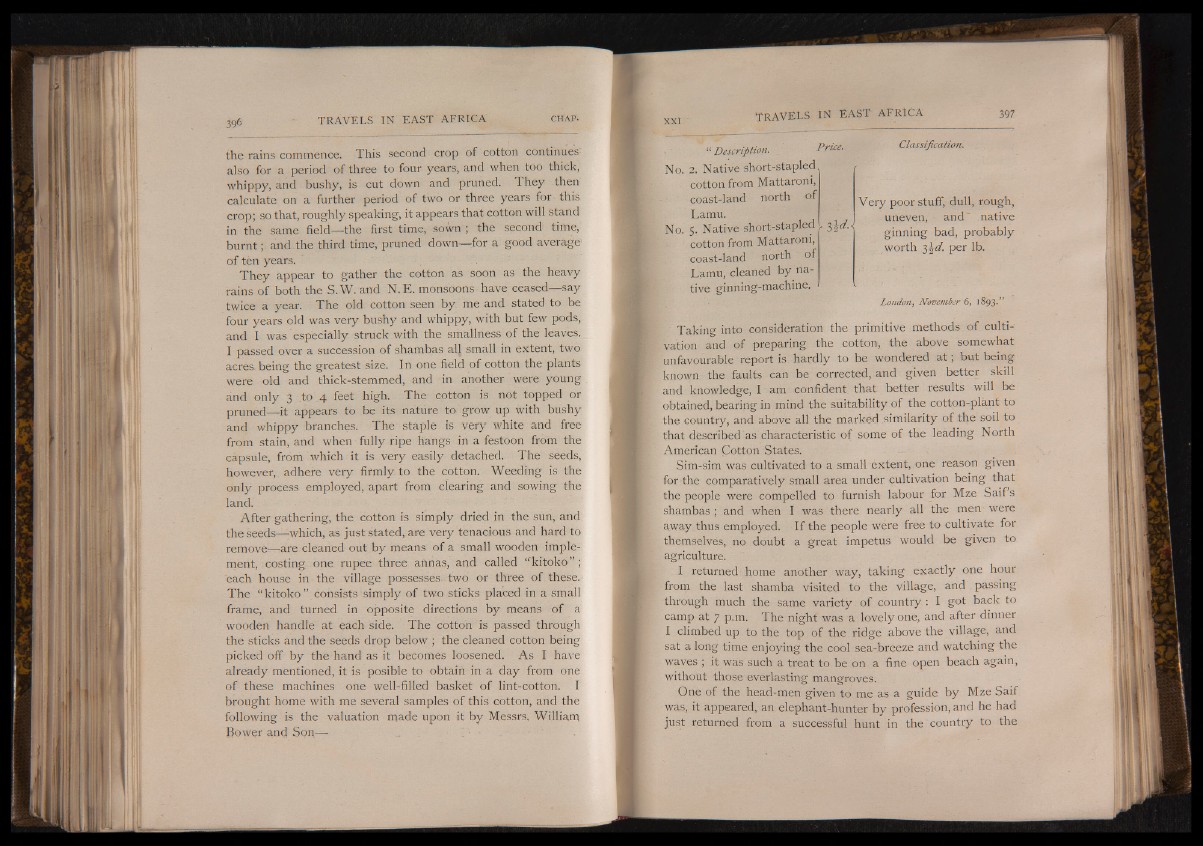
the rains commence. This second crop of cotton continues
also for a period of three to four years, and when too thick,
whippy, and bushy, is cut down and pruned. They then
calculate on a further period of two or three years for this
crop; so that, roughly speaking, it appears that cotton will stand
in the same field— the first time, sown ; the second time,
burnt; and the third time, pruned down— for a good average1
of ten years.
They appear to gather the cotton as soon as the heavy
rains of both the S.W. and N.E. monsoons have ceased— say
twice a year. The old cotton seen by me and stated to be
four years old was very bushy and whippy, with but few pods,
and I was especially struck with the smallness of the leaves.
I passed over a succession of shambas all small in extent, two
acres, being the greatest size. In one field of cotton the plants
were old and thick-stemmed, and in another were young
and only 3 to .4 feet high. The cotton is not topped or
pruned— it appears to be its nature to grow up with bushy
and whippy branches. The staple is very white and free
from stain, and when fully ripe hangs in a festoon from the
capsule, from which it is very easily detached.. The seeds,
however, adhere very firmly to the cotton. Weeding is the
only process employed, apart from clearing and sowing the
land.
After gathering, the cotton is simply dried in the sun, and
the seeds— which, as just stated, are very tenacious and hard to
remove—-are cleaned out by means of a small wooden implement,
costing one rupee three annas, and called <rkitoko ” ;
each house in the village possesses- two or three of these.
The “ kitoko” consists simply of two sticks placed in a small
frame, and turned in opposite directions by means of a
wooden handle at each side. The cotton is passed through
the sticks and the seeds drop below ; the cleaned cotton being
picked off by the hand as it becomes loosened. As I have
already mentioned, it is posible to obtain in a day from one
of these machines one well-filled basket of lint-cotton. I
brought home with me several samples of this cotton, and the
following is the valuation made upon it by Messrs. William
Bower and Son— . T
“ Description.
No. 2. Native short-stapled
cotton from Mattaroni,
coast-land north of
Lamu.
No. 5. Native short-stapled
cotton from Mattaroni,
coast-land north of
Lamu, cleaned by native
ginning-machine.
Price.
3K
Classification.
Very poor stuff, dull, rough,
uneven, and' native
ginning bad, probably
worth 3\d. per lb.
London, November 6, 1893.”
Taking into consideration the primitive methods of cultivation
and of preparing the cotton, the above somewhat
unfavourable report is hardly to be wondered a t; but being
known the faults can be corrected, and given better skill
and knowledge, I am confident that better results will be
obtained, bearing in mind the suitability of the cotton-plant to
the country, and: above all the marked similarity of the soil to
that described as characteristic of some of the leading North
American Cotton States.
Sim-sim was cultivated to a small extent, one reason given
for the comparatively small area under cultivation being that
the people were compelled to furnish labour for Mze Saif s
shambas ; and when I was there nearly all the men were
away thus employed. I f the people were free to cultivate for
themselves, no doubt a great impetus would be given to
agriculture.
I returned home another way, taking exactly one hour
from the last shamba visited to the village, and passing
through much the same variety of country : I got back to
camp at 7 p.m. The night was a lovely one, and after dinner
I climbed up to the top of the ridge above the village, and
sat a long time enjoying the cool sea-breeze and watching the
waves ; it was such a treat to be on a fine open beach again,
without those everlasting mangroves.
One of the head-men given to me as a guide: by Mze Saif
was, it appeared, an elephant-hunter by profession, and he had
just returned from a successful hunt in the country to the